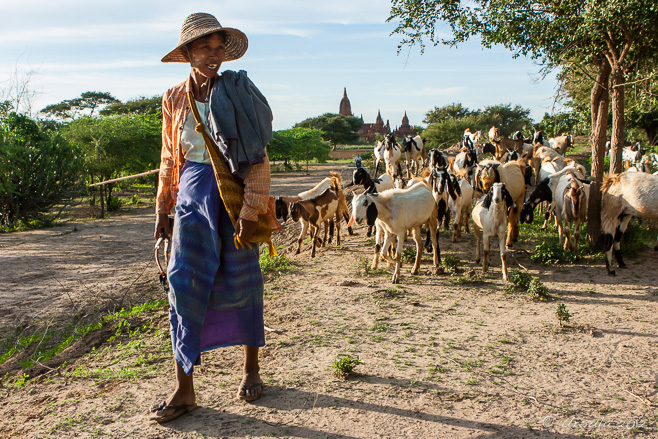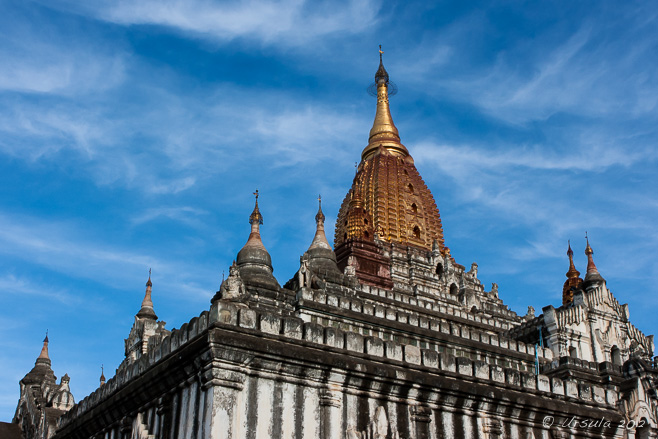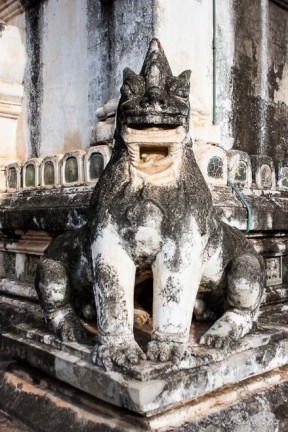
Woman and Goats
In the heat of the Bagan afternoon, everyday life goes on around the ancient temple ruins.
It can be risky travelling through Southeast Asia during the southwest monsoon season: – daily rains can almost be relied upon, and when they come, they tend to be sudden and torrential. They make getting around difficult, especially for tourists who are not necessarily used to wading through the deep, dirty waters that often come with routine flash-flooding, and who don’t have the right wet-weather protection for their expensive belongings. Smelly gutters overflow, disguising potholes and other hazards, and traffic often grinds to a halt when visibility is reduced to zero by the onslaught of the monsoonal downpours.
There are, however, upsides: there tend to be fewer tourists, so prices may be lower and places are less crowded; temperatures are still warm – less stiflingly-hot than summer, but warm enough that a sudden drenching is not unbearable; rains are often short-lived and may even be predictable, and so can be avoided by finding an interesting place to visit during the afternoon thunderstorms; and, because of the warm temperatures, effective rain-protection can involve cheap plastic rain coats – which are readily available – or even shower caps and garbage bags.
And, there are regions which are protected – even during the height of the rainy season – from the worst excesses of weather.
Bagan is in one of these regions.
The magnificent, pagoda-studded plains of Bagan (A Living Landscape) sit in a curve in the Irrawaddy (Ayeyarwady) River, in a rain shadow between the low coastal ranges to the west and the Shan Plateau to the east. This relative ‘dry zone’ experiences, on average, only 30 percent of the annual rainfall received by Yangon.
Not only is this microclimate great for visitors, it is one of the reasons so many of the pagodas have weathered the tests of time. Even so, I tucked my plastic camera-protectors into my camera bag before joining Photographer Karl Grobl and local guide Mr MM on an afternoon’s exploration of Ananda Temple and the fields around Pyathada Paya (Pyathadar/Pyathatgyi Pagoda) Temple – just in case of sudden rain.

Ananda Temple
Called an architectural wonder, Ananda Temple is one of the most famous temples in Bagan.

Stone Lion
Ananda is known as a “veritable museum of stones”.

Temple Porches
Ornate gabled porches project out from each face of the temple’s central square.

Ananda Temple
Built under King Kyansittha in 1105, Ananda Temple is a fusion of Mon and Indian architectural styles. Layed out in a cruciform shape, the corridors lead to a central cube, which houses four standing Buddha statues, facing in each of the four cardinal directions.

The Kassapa (Kashyapa) Buddha
The south facing Buddha is one of two depicting the dhammachakka mudrā, a Bagan-style hand position symbolizing the Buddha’s first sermon.

Kassapa Buddha
… but the closer you get, the sadder, or more contemplative, it looks.

Kassapa Buddha
This Buddha is unique: at a distance, it appears to be smiling …

Koṇāgamana Buddha
The east facing Buddha stands with both arms hanging at the sides with palms stretching out. This is a mudrā not seen in traditional Buddhist sculpture outside this temple.

Koṇāgamana Buddha
The east facing standing Buddha is holding a herb, which symbolically represents the gift of dhamma (Buddhist philosophy) as a cure for human misery and distress.

Out the Arch
A grated archway looks out of a Ananda Temple corridor.

Buddhas in a Niche
The corridors are full of stone images – some guilded and painted; others faint and worn.
As the afternoon drew on, we crossed the main road away from Ananada Temple, to the network of dirt roads that criss-cross the fields and plains. It was time for the herders to bring their flocks home for the night.

Temple in the Afternoon

Cows at the Waterway

Goats and Cows
Sulamani Temple, the “Crowning Jewel”, stands in the background as a goatherd and cowherd stop for a chat.

Across the Furrows
I am amazed that the dry, dusty furrows stay in such good shape with herds of goats crossing them twice daily.

Shepherdess

Bicycles on a Dusty Road
There is a local network of unsealed dirt roads around Pyathadar Pagoda, where we were headed to watch the sun set.

Goats in the Dust
The passing animals raise clouds of dust in the golden afternoon light.

Goatherd

Cows at Pyathadar Temple
The late afternoon light turns the path and the temple warm with colour as the cows travel home through the dust and rubbish.

Setting Sun
The sky turns crazy colours as the sun goes down over the plains …

Pyathadar Ponycart
… and a ponycart-driver tries to get tourists home from the temple before the purple twilight goes dark.

Pyathadar Night Sky
The sky changes colour from moment to moment over the Bagan Plains…

Last Light
… before the light vanishes completely.
 When the last light is gone, we make our way home in the dark.
When the last light is gone, we make our way home in the dark.
It’s dusty and hot – but dry. No rain today on the Plains of Bagan.
Photographs: 18-19September2012




























.png)


Beautiful photo’s to compliment the storyline
I have read just all your blog entries of the last weeks with interest. As always interesting reports and nice photos. Slowly I try now to put an end to my “summer break”, of course I would like to see the summer still long continuing. I love the heat and my muscles as well. As said I try to pick up the thread again slowly. I have spent the last weeks personally, lots of great things, but the terrible things that happened in recent times are not insensible passed away to me.
I will post something on my 3 blogs again soon. Dear greetings, Dietmut
Dear Dietmut,
I am glad to hear you had a good summer – although we are indeed living in difficult times. We are summering in Europe at the moment; England, Switzerland and the Danube… although my Asian and North American photos still wait for me! 😀
Best regards, U